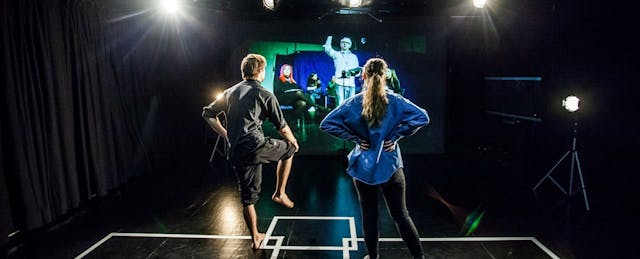Colleges have long linked classrooms via videoconferencing. But when two theater professors in different countries wanted to collaborate, they decided to make a video link with a little more depth.
The project began when Tiina Syrjä, a lecturer in voice and speech at the University of Tampere, in Finland, met an administrator from Coventry University, in Britain, and they decided to organize a collaborative long-distance theater seminar. Coventry University sent Tom Gorman, a senior theater lecturer, to Finland to come up with a plan. Mikko Kanninen, senior lecturer of acting at the University of Tampere, joined the planning committee.
“A colleague of mine had been working in Second Life, an online virtual world,” said Gorman. “He had an installation in an art gallery where there was a big projection and it was hooked up to a screen and a video camera. What was interesting to us was the layout of the room—on the screen was a computer version of that world, but in the room was a real version. We thought, could you take a setup like this and have real participants on both sides instead of using computer graphics?”
The answer was “yes.” A few weeks later, Kanninen sent Gorman a diagram of a possible setup that combined a stage set with video conferencing. Around a dozen students at a time would participate on each side of the virtual rehearsal room. The technical equipment would be invisible, tucked behind a rear projection screen. “We didn’t know whether it was going to work,” says Gorman. “We spent a week tuning it, doing virtual lectures every afternoon, testing latency and twiddling with cameras to make eye contact.”
They focused the project on Shakespeare’s Coriolanus, a tragedy about an ancient Roman leader who faces an angry mob. “The mob are central characters in the play,” says Gorman. “We drew connections to the present, considering that today’s version of the mob could be your social media followers.”
While videoconferencing with apps like Skype and FaceTime has become mainstream, Kanninen points out that their approach requires a higher-quality connection. “It’s still expensive technology,” he says.
While they faced a few technical problems, students rose to the challenge of interacting with their virtual classmates. “There was a little bit of latency, especially on our side,” Syrjä says, causing brief delays that made acting a bit more challenging. “Our students usually had to speak their lines a bit early, but as they got used to that, it started to sound like they were really having a discussion.”
Having grown up in the Internet age, students took over the task of troubleshooting technical difficulties, tackling problems on their own. “We were all helping each other,” Gorman says. “A few times we’d try something and it didn’t work, and a student would say, ‘What if we try it this way?’ Toward the end, they began to dictate quite a bit about what we were doing.”
Syrjä’s favorite moment in the two-week project was when the two groups shared a moment of silence during an acting warm-up. “That was really a magical moment of virtual silence,” she says. “We are all so used to having lots of stimuli online, and it was crazy to think that there was a big distance between people, yet they were sharing the same silence.”
When the Coriolanus Project drew to a close, both groups mourned the loss of their distant friends. “I genuinely felt like I was switching off someone’s life support,” he says. “There was a sense that this [the videoconferencing] was real and the other online communication was virtual.”
Energized by the initial project’s success, Gorman, Syrjä and Kanninen are planning a second project this year, focusing on Shakespeare’s King Lear. This time, the Coventry students will travel to Tampere for a few days of in-person rehearsals and a live performance in addition to the virtual collaborations.
A few other colleges have introduced real-time video or audio collaboration projects via the Internet. “At the University of Edinburgh, they have a system called LOLA that allows distant groups of musicians to play together,” Gorman says. “There’s a similar research project called Online Orchestra, funded by the UK’s Arts and Humanities Research Council.”
While it doesn’t compete with studying abroad, virtual international collaboration offers hope for closer connections between higher education institutions around the world. “Many of my students were intimidated by the idea of international travel and collaboration, but after participating in this project, they changed their minds,” says Kanninen. “If a student wants to go abroad, doing a project like this can lower their anxiety level.”


